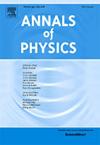Effective Pressure of the FRW Universe
IF 3
3区 物理与天体物理
Q2 PHYSICS, MULTIDISCIPLINARY
引用次数: 0
Abstract
In this paper, we study the effective pressure of the -dimensional FRW(Friedmann–Robertson– Walker) universe in Einstein gravity, Gauss–Bonnet gravity, and Lovelock gravity. The effective pressure is defined by , where is the effective energy and is the volume of the FRW universe inside the apparent horizon. The effective pressure in Einstein gravity is always negative and its absolute value decreases with the horizon radius . The effective pressure in Gauss–Bonnet gravity is different with the one in Einstein gravity only when , and in this case, the effective pressure is not always negative and has a minimum, which is very similar to the potential between molecules. The effective pressure in Lovelock gravity can have multiple zero-points and extreme points. The effective pressure in different dimensions has interesting relations. We also find that under certain condition, the effective pressure is equivalent with the ‘ordinary’ pressure of the perfect fluid, and this condition do not depend on the specific choice of gravitational theories.
FRW宇宙的有效压力
本文研究了n维FRW(friedman - robertson - Walker)宇宙在爱因斯坦引力、高斯-邦尼特引力和洛夫洛克引力下的有效压力。有效压力由Peff定义,其中E=ρV为有效能量,V为视视界内FRW宇宙的体积。在爱因斯坦引力中,有效压力总是负的,其绝对值随视界半径RA而减小。高斯-邦纳引力中的有效压力与爱因斯坦引力中的有效压力只有在N≥6时才不同,并且在这种情况下,有效压力并不总是负的,并且有一个最小值,这与分子间的势非常相似。洛夫洛克重力中的有效压力可以有多个零点和极值点。不同维度的有效压力有有趣的关系。我们还发现,在一定条件下,有效压力等于完美流体的“普通”压力p,而这种条件不依赖于引力理论的具体选择。
本文章由计算机程序翻译,如有差异,请以英文原文为准。
求助全文
约1分钟内获得全文
求助全文
来源期刊

Annals of Physics
物理-物理:综合
CiteScore
5.30
自引率
3.30%
发文量
211
审稿时长
47 days
期刊介绍:
Annals of Physics presents original work in all areas of basic theoretic physics research. Ideas are developed and fully explored, and thorough treatment is given to first principles and ultimate applications. Annals of Physics emphasizes clarity and intelligibility in the articles it publishes, thus making them as accessible as possible. Readers familiar with recent developments in the field are provided with sufficient detail and background to follow the arguments and understand their significance.
The Editors of the journal cover all fields of theoretical physics. Articles published in the journal are typically longer than 20 pages.
 求助内容:
求助内容: 应助结果提醒方式:
应助结果提醒方式:


